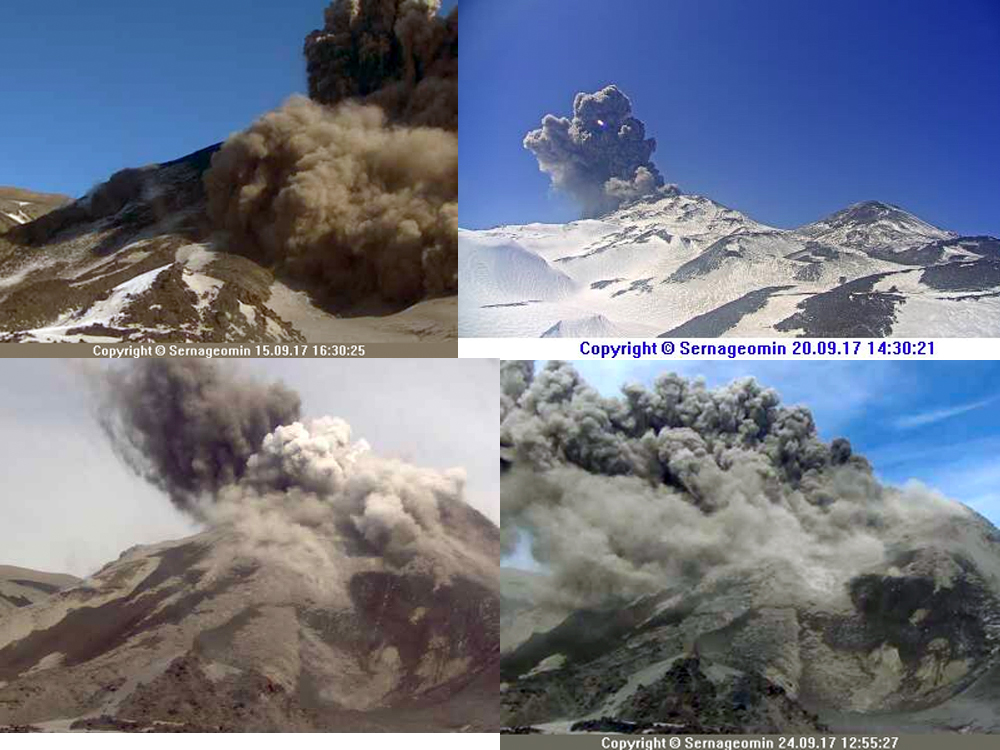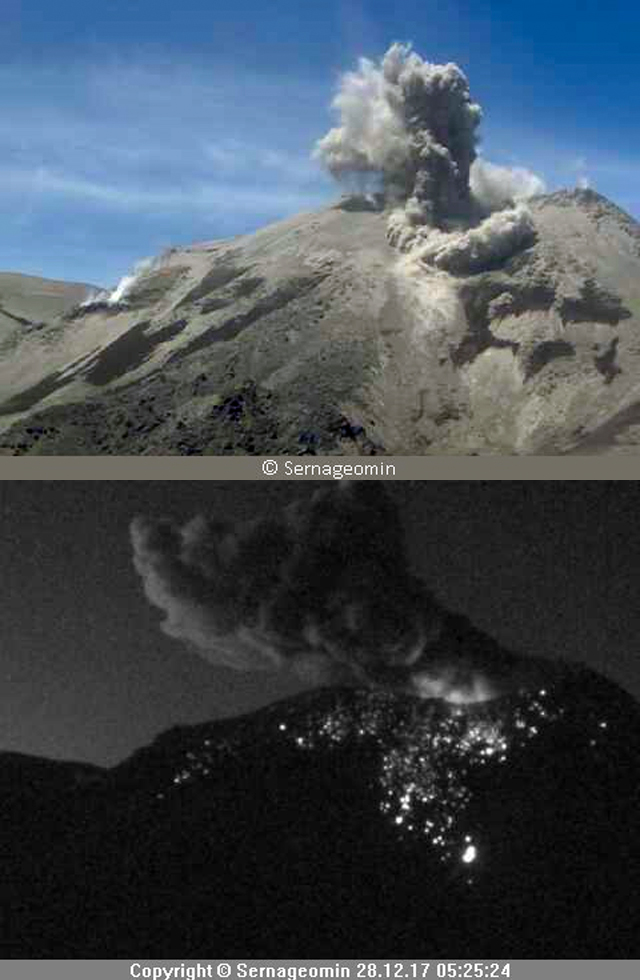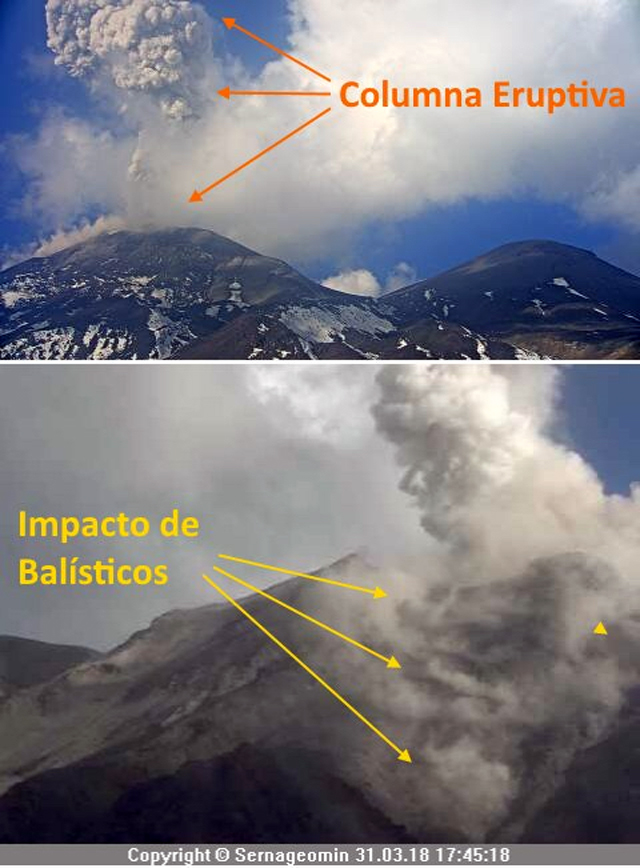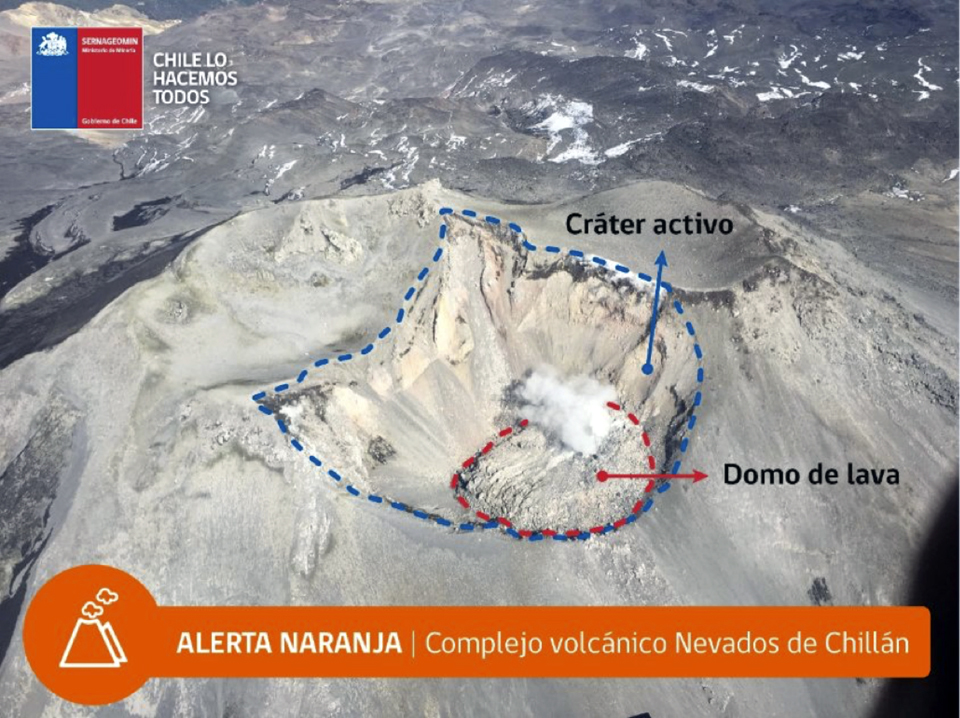Report on Nevados de Chillan (Chile) — June 2018
Bulletin of the Global Volcanism Network, vol. 43, no. 6 (June 2018)
Managing Editor: Edward Venzke.
Edited by A. Elizabeth Crafford.
Nevados de Chillan (Chile) Hundreds of ash-bearing explosions; dome appears in crater in mid-December 2017
Please cite this report as:
Global Volcanism Program, 2018. Report on Nevados de Chillan (Chile) (Crafford, A.E., and Venzke, E., eds.). Bulletin of the Global Volcanism Network, 43:6. Smithsonian Institution. https://doi.org/10.5479/si.GVP.BGVN201806-357070
Nevados de Chillan
Chile
36.868°S, 71.378°W; summit elev. 3180 m
All times are local (unless otherwise noted)
Nevados de Chillán is a complex of late-Pleistocene to Holocene stratovolcanoes constructed in the Chilean Central Andes. The Nuevo and Arrau craters are adjacent vents on the NW flank of the cone of the large stratovolcano referred to as Volcán Viejo. An eruption started with a phreatic explosion and ash emission on 8 January 2016 from a new crater on the E flank of Nuevo. Explosions continued through September 2017 with ash plumes rising several kilometers and Strombolian activity sending ejecta hundreds of meters (BGVN 42:10). This report covers continuing activity from September 2017-May 2018. Information for this report is provided by Chile's Servicio Nacional de Geología y Minería (SERNAGEOMIN)-Observatorio Volcanológico de Los Andes del Sur (OVDAS), Oficina Nacional de Emergencia-Ministerio del Interior (ONEMI), and by the Buenos Aires Volcanic Ash Advisory Center (VAAC).
About 150 ash-bearing explosions were recorded during September and October 2017, with plumes rising almost 2 km above the summit. Activity decreased during the second half of October, and no ash plumes were recorded during November. A significant increase in activity in early December led to over 200 explosions with ash emissions. An overflight on 21 December 2017 produced images of a fissure at the bottom of the new crater. The presence of a growing lava dome in the crater was confirmed in early January 2018. Frequent Strombolian explosions produced nighttime incandescence at the summit and down the flanks. Hundreds of ash-bearing explosions occurred during February 2018; the largest plume rose 2.5 km above the summit, and many smaller pulses produced ash and steam that rose 1.5 km. Sporadic incandescence at night and continued explosions of magmatic gases were typical during March 2018. A large explosion on 31 March coincided with the first appearance of a low-level MODIS thermal anomaly in the MIROVA data, and incandescence from explosions at night indicated that the dome continued to grow during April and May. SERNAGEOMIN reported that the top of the lava dome was visible from the E flank for the first time at the end of May 2018.
Activity during September-December 2017. SERNAGEOMIN reported 117 ash-bearing explosions between 16 and 30 September 2017 (figure 17). The one that released the most energy occurred on 19 September. The plumes of steam and ash rose up to 1,800 m above the crater. The Buenos Aires VAAC observed a narrow plume of ash in satellite imagery moving N at 3.9 km altitude and dissipating rapidly on 15 September, and a similar plume moving SE near the summit on 26 September 2017.
During the first two weeks of October 2017 there were 30 ash-bearing explosions recorded. The Buenos Aires VAAC reported small sporadic puffs of ash on 6 October 2017 that were visible in the webcam (figure 18), but not in satellite data, and a similar dense but short-lived plume on 14 October. SERNAGEOMIN reported a series of pulsating low-energy explosions visible in the webcam that drifted SW on 11 and 12 October 2017, and rose no more than 1 km above the summit.. Only two ash-bearing explosions were recorded during the second half of the month. The volcano was much quieter during November; plumes of steam were observed rising only 100 m above the summit throughout the month, with no ash-bearing plumes reported.
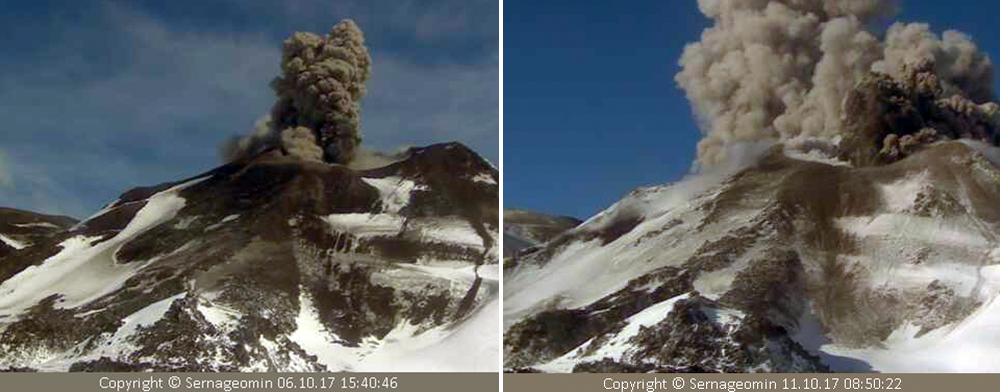 |
Figure 18. Ash plumes at Nevados de Chillán on 6 (left) and 11 (right) October 2017 were two of the 30 plumes recorded during the first half of October. Courtesy of SERNAGEOMIN. |
A significant increase in activity in early December 2017 resulted in 245 explosions associated with ash emissions during the first two weeks, some rising as high as 3,000 m above the summit. The Buenos Aires VAAC reported a puff of ash on 1 December that rose to 3.7 km altitude and drifted S, dissipating rapidly. The next day another plume rose slightly higher, to 4.3 km. A dense emission on 4 December rose to 4.9 km and drifted SE before dissipating in a few hours and was not visible in satellite data. On 11 and 14 December, short-lived emissions rose to 4.3 km (figure 19). A yellow cloud of sulfur formed on 11 December within 300 m of the active crater. The webcams also recorded sporadic nighttime incandescence during increased explosions in the early morning of 14 December. Continuous steam emissions with pulses of minor ash were first noted on 16 December; they were visible in satellite imagery the next day at 3.9-4.3 km altitude drifting NE, and by 18 December, consisted only of water vapor.
In a special report released on 19 December, OVDAS-SERNAGEOMIN reported an increase in surface activity over the previous three days, recording minor explosions averaging four per hour, and seismic pulses lasting 5-10 minutes; they also noted harmonic tremor with the increase in explosion frequency. A detailed review of images taken during an overflight on 21 December revealed a fissure 30-40 m long trending NW at the bottom of the crater. Incandescence at night was regularly observed after 20 December (figure 20), and ash emissions rose to 3,000 m above the summit during the second half of the month.
Activity during January-April 2018. SERNAGEOMIN volcanologists identified a growing lava dome within the new crater during two overflights on 9 and 12 January 2018 (figures 21); it was emerging from the fissure first identified on 21 December. During the first two weeks of January SERNAGEOMIN reported 1,027 pulsating explosions associated primarily with magmatic gases, and very little ash that rose up to 1,000 m above the summit. Confirmed ash emissions were reported on 11 January at 4.3 km altitude faintly visible moving SE in satellite imagery, according to the Buenos Aires VAAC. Nighttime incandescence from the growing dome was periodically observed (figure 22). Based on the overflight data and satellite imagery, they calculated a growth rate for the dome of 1,360 m3 per day. They estimated the size at 37,000 m3 by mid-month.
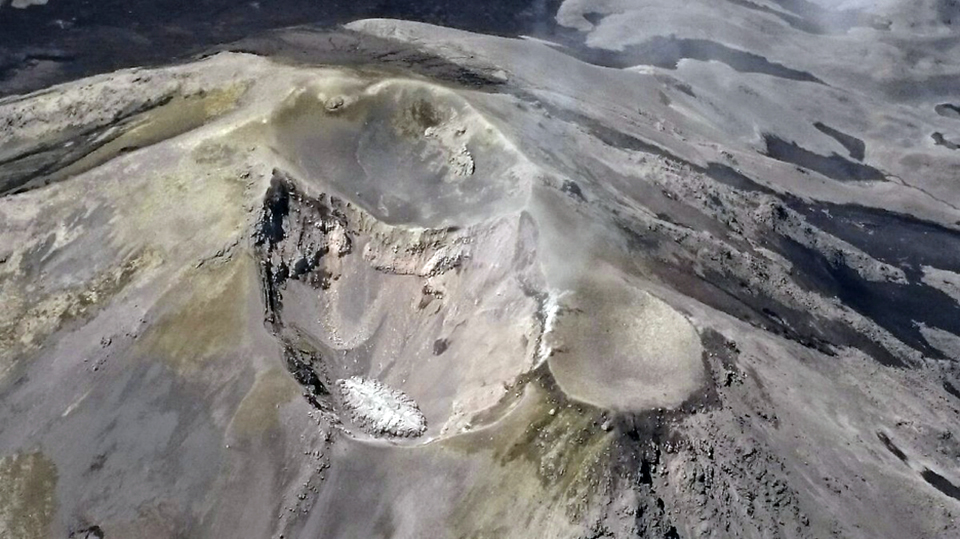 |
Figure 21. During an overflight at Nevados de Chillán on 9 January 2018, SERNAGEOMIN scientists observed the growing dome within the crater. Courtesy of SERNAGEOMIN. |
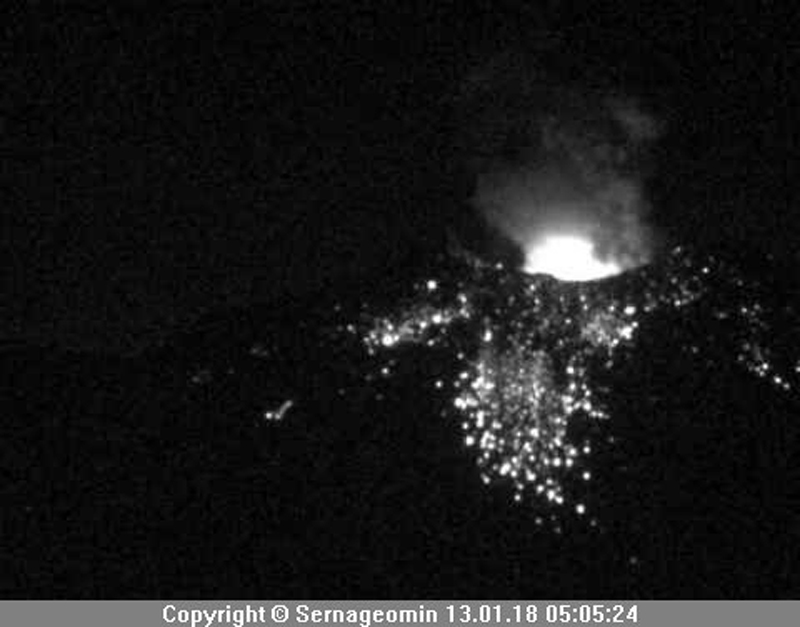 |
Figure 22. Incandescence at night increased from the growing dome at Nevados de Chillán on 13 January 2018. Courtesy of SERNAGEOMIN. |
Overflights on 23 and 31 January measured temperatures of 305-480°C over the surface of the dome, with the highest values at the fissure. The growth rate calculated after these overflights was 2,540 m3 per day. The webcam revealed emissions of ash and water vapor during the second half of the month that rose less than 1,000 m above the summit crater.
An explosion on 2 February 2018 sent an ash plume to 2,500 m above the summit (figure 23). Vibrations from the explosion were reported in Las Trancas (10 km) and at the Gran Hotel Termas de Chillan (5 km). SERNAGEOMIN began referring to the active crater as Nicanor, and the dome was named Gil-Cruz. During the first two weeks of February, 840 explosions associated with plumes of magmatic gases were reported. The plumes generally rose as high as 1,500 m above the summit and were often accompanied by incandescence at night. Two overflights on 7 and 14 February recorded temperatures of 500 and 550°C. SERNAGEOMIN determined a dome growth rate of 1,389 m3 per day, and a total volume of 82,500 m3 by mid-month. At least four explosions on 14 February were characterized by two simultaneous plumes, one of white steam and the other darker with a higher ash content according to SERNAGEOMIN. The highest plume that day reached 1,200 m above the summit crater. The Buenos Aires VAAC also reported a small pulse of ash on 14 February that rose to 4.6 km altitude and drifted SE. The dome continued to grow slowly during the rest of February, with a small increase in size noted during a 22 February flyover. Plumes of mostly water vapor with minor ash rose a maximum of 1,080 m above the summit during the hundreds of small explosions that took place.
Sporadic incandescence at night and continued explosions of magmatic gases were typical during March 2018, with plume heights reaching 2,000 m over the Nicanor crater. During an overflight on 11 March, a temperature of 330°C was measured around the Gil-Cruz dome, which had grown to a volume of about 100,000 m3 but still remained below the crater rim. Morphological changes in the still-slowly growing dome included fracture lines and unstable large vertical blocks. A significant decrease in seismic energy was noted beginning on 24 March that ended when two larger explosions occurred on 30 and 31 March (figure 24).
During an overflight on 3 April 2018, scientists observed energetic pulses of steam and minor ash from the central NW-SE trending fissure inside the crater. They noted that lapilli from explosions had been ejected as far as 1 km from the fissure, and that the Gil-Cruz dome had increased in volume since 11 March; they also observed an area of subsidence on the top of the growing dome (figure 25). The dome was expanding toward the E side of the crater, and the top of the dome rose above the crater rim. They measured a maximum temperature of 670°C on the surface of the dome. The decrease in daily seismicity, the larger explosions of the previous days, and the increased size of the dome with greater risk of collapse, pyroclastic flows, and lahars, all led SERNAGEOMIN to raise the alert level at Chillan to Orange on 5 April 2018.
The Buenos Aires VAAC reported continuous emissions of steam and gas with minor ash along with a small pulse of ash on 2 April 2018. Low-altitude plumes of mostly water vapor were common throughout April 2018. Incandescence from explosions was visible on clear nights during the month, and ejecta rose as high as 250 m above the crater and was scattered around the crater rim. Seismicity remained constant at moderate levels related to the repeated explosions and the growth of the dome. A faint ash plume could be seen in visible satellite imagery on 18 April at 3.7 km altitude drifting E.
Observations reported on 1 May 2018 from the previous flyover indicated that the rate of growth of the dome had slowed to about 690 m3 per day, and the estimated volume had grown to about 150,000 m3. Activity remained at similar levels throughout May 2018. Seismic instruments recorded long-period seismicity and tremor episodes similar to previous months that corresponded with surface explosions and the extrusion of the lava dome. Seismic energy levels were moderate but fluctuated at times. Plumes of predominantly water vapor with minor gas rose a few hundred meters above the summit drifting generally S or SE before dissipating. Incandescence was often observed on clear nights, accompanied by ejection of incandescent blocks that were observed generally 100 to 150 m above the active crater. A larger explosive event took place on 7 May. Occasional plumes with minor ash were reported on 11 May. SERNAGEOMIN reported on 24 May 2018 that the top of the lava dome was visible from the E flank.
Geological Summary. The compound volcano of Nevados de Chillán is one of the most active of the Central Andes. Three late-Pleistocene to Holocene stratovolcanoes were constructed along a NNW-SSE line within three nested Pleistocene calderas, which produced ignimbrite sheets extending more than 100 km into the Central Depression of Chile. The dominantly andesitic Cerro Blanco (Volcán Nevado) stratovolcano is located at the NW end of the massif. Volcán Viejo (Volcán Chillán), which was the main active vent during the 17th-19th centuries, occupies the SE end. The Volcán Nuevo lava-dome complex formed during 1906-1945 on the NW flank of Viejo. The Volcán Arrau dome complex was then constructed on the SE side of Volcán Nuevo between 1973 and 1986, and eventually exceeded its height. Smaller domes or cones are present in the 5-km valley between the two major edifices.
Information Contacts: Servicio Nacional de Geología y Minería, (SERNAGEOMIN), Observatorio Volcanológico de Los Andes del Sur (OVDAS), Avda Sta María No. 0104, Santiago, Chile (URL: http://www.sernageomin.cl/); Oficina Nacional de Emergencia - Ministerio del Interior (ONEMI), Beaucheff 1637/1671, Santiago, Chile (URL: http://www.onemi.cl/); Buenos Aires Volcanic Ash Advisory Center (VAAC), Servicio Meteorológico Nacional-Fuerza Aérea Argentina, 25 de mayo 658, Buenos Aires, Argentina (URL: http://www.smn.gov.ar/vaac/buenosaires/inicio.php); MIROVA (Middle InfraRed Observation of Volcanic Activity), a collaborative project between the Universities of Turin and Florence (Italy) supported by the Centre for Volcanic Risk of the Italian Civil Protection Department (URL: http://www.mirovaweb.it/).


